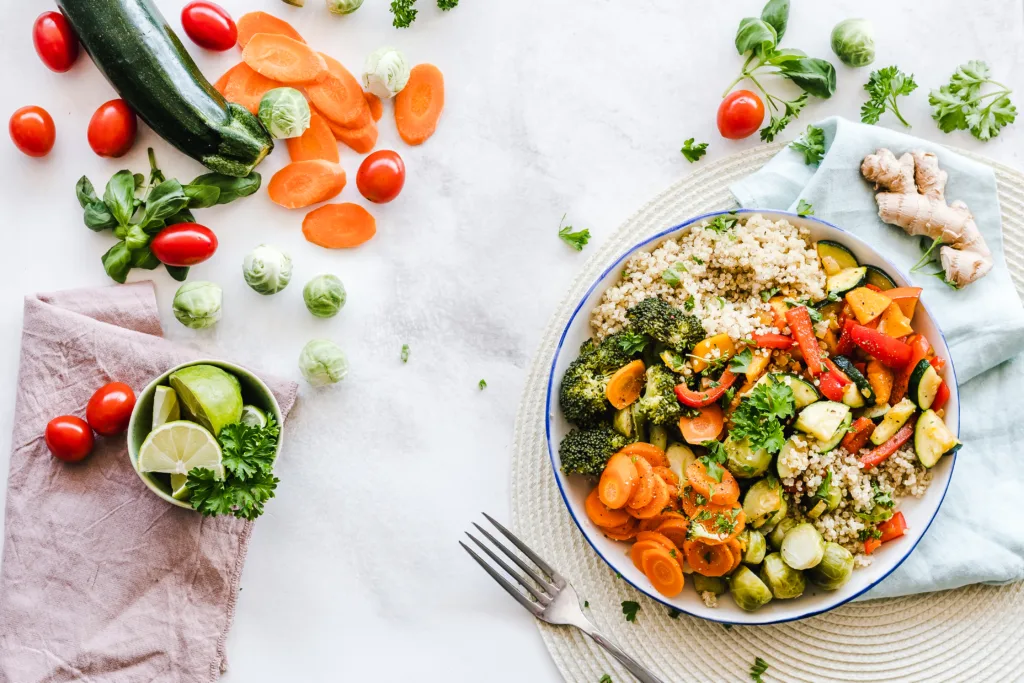Carrots are a crunchy and nutritious snack, but can they be included in a low FODMAP diet?
Eating a low FODMAP diet is essential for people with digestive issues such as irritable bowel syndrome (IBS). But it can be confusing to know which foods are safe to eat. This article will answer the question, “Are carrots low FODMAP?”, and provide helpful information on how much you can safely eat.
The article will also discuss other vegetables that are considered low FODMAP, and provide tips for cooking carrots so they are easier to digest. With this information, you can confidently add carrots to your low FODMAP diet.Yes, carrots are considered low FODMAP. Carrots are a great source of vitamins and minerals, and are a suitable vegetable for those following the low FODMAP diet.
FODMAP
FODMAP stands for Fermentable Oligo-, Di-, Mono-saccharides and Polyols. It is a group of short-chain carbohydrates (sugars) found in food that can be difficult for some people to digest. FODMAPs are found naturally in a variety of foods including wheat, onions, garlic, apples, honey, and dairy products. They are also used as food additives or preservatives to enhance flavor and texture. People with digestive issues such as irritable bowel syndrome (IBS) may find that reducing their intake of FODMAPs can help alleviate symptoms.
The low FODMAP diet involves eliminating high FODMAP foods from the diet and then reintroducing them one at a time to determine which ones cause symptoms. Foods that are considered high in FODMAPs include wheat, onions, garlic, apples, honey, and dairy products. Low FODMAP foods include quinoa, rice, potatoes, lettuce, carrots, bananas and most other fruits and vegetables.
For people with IBS or other digestive issues related to intolerance of FODMAPs it is advisable to consult with a healthcare professional before starting the low FODMAP diet as it may not be suitable for everyone. A registered dietitian can help you plan an appropriate diet tailored to your individual needs and health goals.
Low FODMAP Diet
The Low FODMAP Diet is a dietary approach that focuses on limiting certain carbohydrates called FODMAPs, which are found in a variety of foods. This diet was developed by researchers at Monash University in Australia and is used to help people with gastrointestinal issues such as irritable bowel syndrome (IBS) manage their symptoms. The diet involves eliminating high FODMAP containing foods and gradually reintroducing them in order to identify which foods trigger IBS symptoms. By understanding which foods cause symptoms, people can better manage their diets and reduce their symptoms. Additionally, the Low FODMAP Diet may also be beneficial for those with other digestive issues such as celiac disease or inflammatory bowel disease.
Click here to preview your posts with PRO themes ››
The Low FODMAP Diet is not intended to be followed for an extended period of time; instead it should be used as a tool to identify food triggers. The elimination phase typically lasts two to six weeks, followed by a reintroduction phase where foods containing FODMAPs are gradually added back into the diet. After the reintroduction phase is complete, a balanced diet containing some high-FODMAP foods may still be beneficial for symptom management. It’s important to note that everyone’s response to different types of food may vary, so it’s best to talk with your doctor or nutritionist before beginning the Low FODMAP Diet.
What are the Benefits of Eating Low FODMAP Foods?
Eating a low FODMAP diet is becoming increasingly popular as a way to reduce digestive discomfort and improve overall gut health. The diet focuses on avoiding foods containing certain carbohydrates called FODMAPs, which can cause bloating, gas and other digestive issues. By eliminating these foods from your diet, you can reap a number of health benefits that help you feel better overall.
One of the biggest benefits of eating a low FODMAP diet is that it can help to reduce digestive symptoms such as bloating, gas, abdominal pain and diarrhea. By avoiding high-FODMAP foods, you can decrease the amount of gas-producing bacteria in your gut, which can help relieve uncomfortable symptoms. Additionally, eating a low FODMAP diet may also help to reduce inflammation in your gut, which can further reduce symptoms associated with irritable bowel syndrome (IBS).
Additionally, eating a low FODMAP diet may improve nutrient absorption in the gut. By avoiding high-FODMAP foods, you can decrease gastrointestinal distress and increase nutrient absorption. This means that you’ll be able to get more out of the food that you eat and feel more nourished overall. Eating a low FODMAP diet may also help to boost your immunity by improving your gut microbiome balance.
Finally, following a low FODMAP diet may also help to improve mental health by reducing stress and anxiety levels. Eating a balanced diet is important for overall well-being and eating a low FODMAP diet allows for more nutritional diversity in your meals. This dietary approach has been shown to reduce stress levels and improve mood due to its focus on whole food sources and variety in meals.
In conclusion, there are many potential benefits of eating a low FODMAP diet including reducing digestive issues such as bloating and abdominal pain; improving nutrient absorption; boosting immunity; and improving mental health. If you’re looking for an effective way to improve your health while avoiding certain irritating foods then this might be the right dietary approach for you!
Carrot as a High or Low FODMAP Vegetable
Carrots are a popular vegetable, but if you’re following a low FODMAP diet, it can be confusing to determine whether carrots are high or low FODMAP. Carrots are considered low FODMAP in servings of up to 1/2 cup (75 g). That’s because the fructans content of carrots is relatively low and easily tolerated. All other parts of the carrot plant are high in fructans and should be avoided on a low FODMAP diet, including carrot greens and carrot juice. If you’re eating more than 1/2 cup (75 g) of carrots at one time, you may experience symptoms due to their higher fructan content.
Click here to preview your posts with PRO themes ››
It’s important to note that carrots can be prepared in different ways that affect their FODMAP content. For example, boiled or roasted carrots are generally lower in fructans than raw carrots. This is because boiling and roasting help break down some of the fructans into simpler sugars which are easier for your body to digest. However, it’s still best to stick with lower-FODMAP serving sizes when preparing carrots to ensure you don’t overdo it on your FODMAP intake.

How to Cook Carrots for a Low FODMAP Diet?
Cooking carrots for a low FODMAP diet doesn’t have to be difficult. If you are following a low FODMAP diet, it is important to know which types of carrots are safe to eat. Generally, peeled and cooked carrots are considered safe for those on a low FODMAP diet, as long as they are cooked without added ingredients that may contain high FODMAP foods.
When cooking carrots for a low FODMAP diet, there are several methods that can be used. Boiling is one of the most popular and simple ways to cook carrots. Peel the carrots and cut into smaller pieces if desired, then place in boiling water until they are tender. You can also steam carrots in a steamer basket over boiling water or roast them in the oven with olive oil and any desired seasonings.
It is important to note that some people on a low FODMAP diet may not tolerate raw carrots due to their high levels of fructose. If this is the case, it is best to avoid eating raw carrots or opt for cooked alternatives instead. Additionally, canned or pickled vegetables should also be avoided as they can contain high levels of added sugar and other ingredients that may not be suitable for a low FODMAP diet.
Overall, cooking carrots for a low FODMAP diet doesn’t have to be complicated. Boiling, steaming, or roasting are all great methods for preparing safe and tasty dishes with this vegetable. As long as you avoid adding high FODMAP ingredients such as garlic or onion and opt for cooked alternatives instead of raw options, you can easily enjoy this healthy food on your low FODMAP journey!
How Many Carrots Can I Eat on a Low FODMAP Diet?
Eating carrots on a low FODMAP diet can be tricky. While carrots are a good source of vitamins, minerals, and fiber, they are also high in natural sugars that can trigger digestive issues for those with irritable bowel syndrome (IBS) or other gastrointestinal disorders. The good news is that there are ways to enjoy carrots while still staying within the low FODMAP guidelines.
For starters, it’s important to understand the types of carbohydrates found in carrots. Carrots contain both fructose and polyols, which are both types of carbohydrates known as FODMAPs (fermentable oligosaccharides, disaccharides, monosaccharides and polyols). FODMAPs can be difficult for people with IBS and other digestive issues to digest properly and can cause gas, bloating, abdominal pain, and other unpleasant symptoms.
Click here to preview your posts with PRO themes ››
The recommended serving size for carrots on a low FODMAP diet is ½ cup (75 grams) of cooked carrots per sitting. This amount contains only trace amounts of FODMAPs and should not trigger any symptoms for most people. However, if you find that eating this much still causes digestive discomfort, you may want to reduce your portion size even further or avoid carrots altogether.
It’s also important to note that raw carrots contain more FODMAPs than cooked ones do. Therefore, it’s best to stick with cooked or steamed carrots if you’re following a low FODMAP diet. Additionally, make sure to pay attention to how your body responds after eating different foods so you can better understand what works best for you.
Ultimately, it’s possible to enjoy carrots while following a low FODMAP diet – just make sure not to exceed the recommended serving size of ½ cup (75 grams) per sitting. If this still causes digestive discomfort or triggers any unpleasant symptoms, try reducing your portion size even further or avoiding them altogether until you better understand how your body responds.
What Foods Should I Avoid When Following a Low FODMAP Diet?
When following a low FODMAP diet, there are certain foods that should be avoided. These include high FODMAP foods such as wheat, garlic, onions, apples, pears, watermelon, honeydew melon, stone fruits such as peaches and plums, dairy products like milk and yogurt, legumes such as beans and lentils, mushrooms and cashews. Additionally, some processed foods may contain hidden FODMAPs like high fructose corn syrup or inulin.
Foods that are naturally low in FODMAPs include most vegetables (except for those listed above), most fruits (except for those listed above), nuts other than cashews, quinoa and rice. Additionally, some artificial sweeteners like sucralose or stevia may also be suitable for a low FODMAP diet.
It is important to speak to your doctor or dietitian before starting any new diet to ensure you are getting the right balance of nutrients. If you have any questions about which foods to avoid when following a low FODMAP diet, your doctor or dietitian can help provide guidance and advice.

Conclusion
Carrots are generally considered low FODMAP, however, the amount of FODMAPs present in carrots does depend on the size and preparation. Therefore, it is important to consider these factors when consuming carrots if following a low FODMAP diet. Additionally, other factors such as tolerance levels and cooking methods should be taken into account. Overall, carrots can be a part of a low FODMAP diet but it is important to eat them in moderation.
In conclusion, carrots can be included in a low FODMAP diet as long as they are eaten in moderation and prepared according to the guidance provided by your healthcare professional or registered dietitian. Eating too many carrots can lead to symptoms of IBS so it is important to know your limits when it comes to eating this vegetable.

